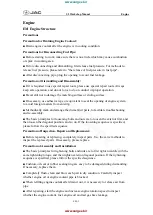
Points To Remember – 2.2L Diesel
NOTE:
When the vehicle is stopped after a few
miles (kilometers) of operation, you may
observe vapor coming from the front of the
engine compartment. This is normally a re-
sult of moisture from rain, or high humidity
accumulating on the radiator and being va-
porized when the thermostat opens, allow-
ing hot coolant to enter the radiator.
If an examination of your engine compartment
shows no evidence of radiator or hose leaks,
the vehicle may be safely driven. The vapor will
soon dissipate.
•
Do not overfill the coolant recovery bottle.
•
Check the coolant freeze point in the radiator
and in the coolant recovery bottle. If anti-
freeze needs to be added, the contents of the
coolant recovery bottle must also be pro-
tected against freezing.
•
If frequent coolant additions are required, or
if the level in the coolant recovery bottle does
not drop when the engine cools, the cooling
system should be pressure tested for leaks.
•
Maintain coolant concentration at 50% HOAT
engine coolant (minimum) and distilled water
for proper corrosion protection of your en-
gine, which contains aluminum components.
•
Make sure that the radiator and coolant re-
covery bottle overflow hoses are not kinked
or obstructed.
•
Keep the front of the radiator clean. If your
vehicle is equipped with air conditioning,
keep the front of the condenser clean.
•
Do not change the thermostat for Summer or
Winter operation. If replacement is ever nec-
essary, install ONLY the correct type thermo-
stat. Other designs may result in unsatisfac-
tory coolant performance, poor gas mileage,
and increased emissions.
Brake System
In order to assure brake system performance,
all brake system components should be in-
spected periodically. Refer to the “Maintenance
Schedule” for the proper maintenance intervals.
WARNING!
Riding the brakes can lead to brake failure
and possibly a collision. Driving with your
foot resting or riding on the brake pedal can
result in abnormally high brake tempera-
tures, excessive lining wear, and possible
brake damage. You would not have your full
braking capacity in an emergency.
Brake Master Cylinder
The fluid level in the master cylinder should be
checked when performing under hood services,
or immediately if the brake system warning light
is on.
Be sure to clean the top of the master cylinder
area before removing the cap. If necessary, add
fluid to bring the fluid level up to the require-
ments described on the brake fluid reservoir.
Fluid level can be expected to fall as the brake
pads wear. The brake fluid level should be
checked when the pads are replaced. However,
low fluid level may be caused by a leak and a
checkup may be needed.
234
Содержание Compass
Страница 1: ...Compass O P E R A T I N G I N F O R M A T I O N...
Страница 2: ......
Страница 3: ......
Страница 4: ......
Страница 6: ...2...
Страница 11: ...7...
Страница 64: ...60...
Страница 84: ...80...
Страница 85: ...81...
Страница 86: ...82...
Страница 118: ...114...
Страница 122: ...INSTRUMENT CLUSTER GAS 118...
Страница 123: ...INSTRUMENT CLUSTER DIESEL 119...
Страница 138: ...Compass Variance Map 134...
Страница 149: ...145...
Страница 153: ...Control Setting Suggestions for Various Weather Conditions 149...
Страница 154: ...150...
Страница 204: ...200...
Страница 277: ...SPAIN 290 SWEDEN 290 SWITZERLAND 290 TAIWAN 291 TURKEY 291 UKRAINE 291 UNITED KINGDOM 292 URUGUAY 292 VENEZUELA 292 273...
Страница 297: ...293...
Страница 298: ...294...
Страница 299: ...10 INDEX 295...
Страница 308: ......
Страница 309: ......
Страница 310: ...Chrysler Group LLC 14MK49 126 EE AA Printed in Europe 14...
















































